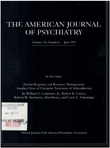Agoraphobia without panic: clinical reappraisal of an epidemiologic finding
Abstract
OBJECTIVE: In the United States, the consensus among clinicians and researchers, reflected in DSM-III-R, is that agoraphobia is a conditioned response to panic attacks and almost never occurs without panic attacks. The predominant view in the United Kingdom is that agoraphobia frequently occurs in the absence of panic. While clinicians report that they rarely see patients with agoraphobia who have no history of panic disorder, community studies report that agoraphobia without panic disorder is common. For example, the Epidemiologic Catchment Area (ECA) study found that 68% of 961 persons with agoraphobia had no history of panic attacks or disorder. METHOD: To understand this discrepancy, 22 subjects who had been diagnosed as having agoraphobia without panic disorder or panic attacks in the ECA study were blindly reinterviewed 7-8 years later with the Schedule for Affective Disorders and Schizophrenia--Lifetime Version Modified for the Study of Anxiety Disorders; data from these interviews were blindly reviewed by a research psychiatrist who was not involved in the original data collection or the reinterview process. RESULTS: On reappraisal, 19 of the 22 subjects had simple phobias or fears but not agoraphobia. One subject had probable agoraphobia without panic attacks, one had definite panic disorder with agoraphobia, and one had probable agoraphobia with limited symptom attacks. CONCLUSIONS: Epidemiologic studies that used the Diagnostic Interview Schedule and lay interviewers, such as the ECA study, may have over-estimated the prevalence of agoraphobia without panic. Agoraphobia without panic attacks occurs but is uncommon, and the diagnostic boundary between agoraphobia and simple phobia is unclear.
Access content
To read the fulltext, please use one of the options below to sign in or purchase access.- Personal login
- Institutional Login
- Sign in via OpenAthens
- Register for access
-
Please login/register if you wish to pair your device and check access availability.
Not a subscriber?
PsychiatryOnline subscription options offer access to the DSM-5 library, books, journals, CME, and patient resources. This all-in-one virtual library provides psychiatrists and mental health professionals with key resources for diagnosis, treatment, research, and professional development.
Need more help? PsychiatryOnline Customer Service may be reached by emailing [email protected] or by calling 800-368-5777 (in the U.S.) or 703-907-7322 (outside the U.S.).



